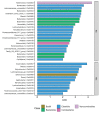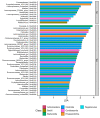The Interplay Between Use of Biological Therapies, Psychological State, and the Microbiome in IBD
- PMID: 35928295
- PMCID: PMC9345200
- DOI: 10.3389/fmed.2022.788992
The Interplay Between Use of Biological Therapies, Psychological State, and the Microbiome in IBD
Abstract
Background: This study examines longitudinal bio-psychological dynamics and their interplay in IBD patients undergoing conventional and biological therapies.
Methods: Fifty IBD participants (24 UC, 26 CD) in clinical remission were followed for 12 months. Complete longitudinal datasets, biological samples, validated scores of psychological status were collected monthly for analysis of association. Microbiome analysis was performed to identify microbial dynamics and signatures. Patients were grouped on disease phenotype (CD, UC) and mode of treatment (biological therapies, non-biological treatment). General linear models, mixed models, cluster analysis, and analyses of variance were used to examine the longitudinal trends of the variables and their associations over time. Results were corrected for multiple testing.
Results: Results substantiated different interactions between biological therapy and longitudinal trends of inflammatory biomarkers in remission CD and UC patients as well as significant differences between CD and UC patients in their psychological measures during clinical remission, with UC patients having inferior condition compared to CD. A significant reduction in microbial diversity in CD patients compared to UC was identified. Results characterized considerable differences in longitudinal microbial profile between those taking and not taking biological treatment in UC patients, but not in CD patients.
Conclusion: A different trajectory of interdependence was identified between psychological state, sleep, and microbial dynamics with mode of treatment when compared between CD and UC patients. Further studies should investigate the causal relationships between bio-psychological factors for improved treatment purposes.
Keywords: Crohn's disease; gut microbiome; inflammatory bowel disease; psychological state; ulcerative colitis.
Copyright © 2022 Tavakoli, Vollmer-Conna, Hadzi-Pavlovic, Vázquez-Campos and Grimm.
Conflict of interest statement
The authors declare that the research was conducted in the absence of any commercial or financial relationships that could be construed as a potential conflict of interest.
Figures











Similar articles
-
Two-Sample Mendelian Randomization Analysis Investigates Causal Associations Between Gut Microbial Genera and Inflammatory Bowel Disease, and Specificity Causal Associations in Ulcerative Colitis or Crohn's Disease.Front Immunol. 2022 Jul 4;13:921546. doi: 10.3389/fimmu.2022.921546. eCollection 2022. Front Immunol. 2022. PMID: 35860271 Free PMC article.
-
A Review of Inflammatory Bowel Disease: A Model of Microbial, Immune and Neuropsychological Integration.Public Health Rev. 2021 May 5;42:1603990. doi: 10.3389/phrs.2021.1603990. eCollection 2021. Public Health Rev. 2021. PMID: 34692176 Free PMC article. Review.
-
Fungal and Bacterial Loads: Noninvasive Inflammatory Bowel Disease Biomarkers for the Clinical Setting.mSystems. 2021 Mar 23;6(2):e01277-20. doi: 10.1128/mSystems.01277-20. mSystems. 2021. PMID: 33758031 Free PMC article.
-
Deciphering Microbial Composition in Patients with Inflammatory Bowel Disease: Implications for Therapeutic Response to Biologic Agents.Microorganisms. 2024 Jun 21;12(7):1260. doi: 10.3390/microorganisms12071260. Microorganisms. 2024. PMID: 39065032 Free PMC article.
-
Conventional therapy for moderate to severe inflammatory bowel disease: A systematic literature review.World J Gastroenterol. 2019 Mar 7;25(9):1142-1157. doi: 10.3748/wjg.v25.i9.1142. World J Gastroenterol. 2019. PMID: 30863001 Free PMC article.
References
LinkOut - more resources
Full Text Sources

